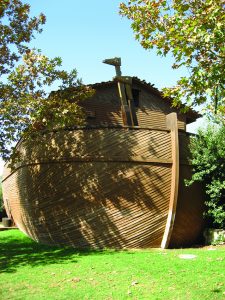
by: Peter Fast, Deputy National Director, Canada

Photo: Eddelene Marais/ Bridges for Peace
The history of the zoo is unique and stands as an example of Jewish determination to see something come to fruition that has worth and meaning. Started in 1940, the zoo underwent many changes and relocations in its infancy before arriving at its final resting place in southern Jerusalem in 1993. This was possible through the combined efforts and investments of the Municipality of Jerusalem, the Jerusalem Foundation, the Jerusalem Development Authority, and the Israel Ministry of Tourism.
The mission and vision of the zoo is found on their official Web page (www.jerusalemzoo.org.il) and is summarized as maintaining a zoological collection living under optimal conditions, preservation of rare animals, and a special emphasis on biblical animals native to Israel. It also seeks to develop educational activities and outreach programs, to cultivate values of nature conservation, and to happily promote an appreciation of nature and the environment.
The zoo not only displays animals to the public, but also works toward the restoration of animals in need, whether affected by sickness or extinction. This is done through such facilities as The Gabi Center and the Beverly Burge Lab. These facilities house hospitals, quarantine units, and laboratories where professional zoologists, veterinarians, and naturalists can work and maintain the enormous demand upon them to host an animal population that size.

Photo: Peter Fast/ Bridges for Peace
Situated around a large manmade lake fed by pools and waterfalls, the zoo is public-friendly and a lovely spot, which sees hundreds of thousands of visitors each year enter through its gates. As of 2009, the zoo contains 271 species and over 2,200 animals. Some of the zoo’s highlights are the Noah’s Ark Visitor’s Center, the Children’s Zoo and Sculpture Garden, and the Noah’s Ark Sculpture Garden. Apart from the usual sightseeing and exploring, the zoo also hosts activities for the Jewish feasts, such as Succot (Feast of Tabernacles), Purim (Feast of Esther), Hanukkah (Feast of Dedication), and Pesach (Passover), and organizes parties, plays, games, and many more activities to get families involved and to spread a love for nature and wildlife.
The zoo also hosts many fascinating exhibitions. ”The Joy of Birds” and ”Vultures in Israel” are exhibits that demonstrate beauty through photography. Photographers and volunteers of the zoo, such as Yoram Shpirer or Ruth Schueler, display the intricacies, color, and magnificence of birds through the lens of their cameras and the detail of the eye.

Photo: Peter Fast/ Bridges for Peace
But a new excitement stirs within when you try to capture nature with your own camera. If you are someone who loves animals as much as myself, you understand the feeling. This excitement I speak of is provoked by the animal lover’s natural curiosity and desire to get as close to the animal as possible to get the best picture. Once you have done that, you can simply stare in awe and admire the creature. It is always a feeling of joy and elation when a monkey stares at you with a quirky glance, or a yawning lion bares his white teeth and you manage to capture the moment.
As you saunter along the comfortable walking paths or take the zoo train, you will notice many biblical animals scattered throughout the park: the Asian lion, Nubian ibex, Palestine gazelle, Persian leopard, Syrian brown bear, crowned crane, Eurasian Scops owl, white-tailed eagle, and the ostrich, just to name a few. These are all animals which have either inhabited Israel at one time, or still inhabit the Land today. Every animal is explained on signs that present important information including weight, class, diet, natural habitat, current condition in the wild, and other fun facts (for example, an ostrich egg is the size of 24 chicken eggs!).

Photo: www.jerusalemzoo.org.il
The Jerusalem Biblical Zoo is a unique experience set in a city filled with ancient and modern history. Amidst the most contested real estate in the world with a diverse religious influence, the zoo gives the tourist a chance to lose oneself within a “Garden of Eden.”
Now, no zoo will come close to an experience in the wild, like Kruger National Park in South Africa, but for many who may never get that chance, a zoo is always a great place to start. One can expect a visit to the zoo to be enjoyable, relaxing, and pleasant. It gives the visitor a break from the historical aspect surrounding Jerusalem’s touring sights and provides the opportunity to bask in the glory of God’s creation and to see the wonder of the animal kingdom up close and personal. If I had five words of advice for you, it would be simple—go and check it out!
All logos and trademarks in this site are property of their respective owner. All other materials are property of Bridges for Peace. Copyright © 2025.
Website Site Design by J-Town Internet Services Ltd. - Based in Jerusalem and Serving the World.